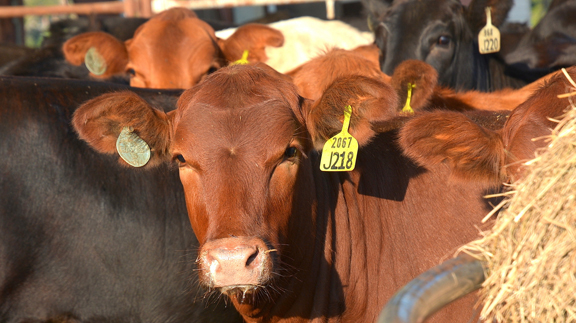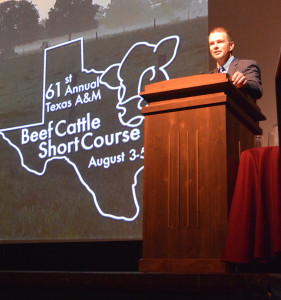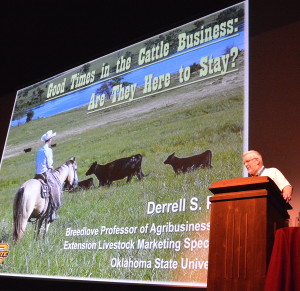Farm & Ranch
‘Exciting_times’_in the cattle business moving forward

By: Blair Fannin
Texas A&M Beef Cattle Short Course features cattle market outlook, trends
Writer: Blair Fannin, 979-845-2259, [email protected]
COLLEGE STATION – As temperatures in College Station reached 100 degrees during Monday’s opening general session of the 61st Texas A&M Beef Cattle Short Course, it could also accurately describe a red-hot cattle market the past two years.
“These are exciting times indeed, but are they here to stay?” said Dr. Jason Cleere, conference coordinator and Texas A&M AgriLife Extension beef cattle specialist, addressing one of the highest-attended short course events ever.
More than 1,680 beef cattle producers gathered at Texas A&M to hear the latest about the cattle market and future trends.
“I think there is a lot to look forward to down the road,” Cleere told attendees.
Dr. Derrell Peel, Oklahoma State University livestock marketing economist, said the cattle market may have topped earlier this year, but don’t expect a downward spiral in prices anytime soon. However, Peel said to “prepare for lower prices” according to decades of past charts and data.
“It’s been fun on the way up; it’s been easy to make money on the way up,” Peel said. “There still will be some good times ahead, but you’re going to have to manage costs in relation to the market. It all goes back to cost management. Now is a good time to invest some of those good returns you’ve had to help manage costs over the next few years. That might be investing in (replacement) females or brush control. I’m still optimistic. The best cure for high prices is high prices.”
According to the latest U.S. Drought Monitor, Peel said, drought conditions have improved dramatically and beef producers “have been able to switch from defense to offense” in building back herds.
“We are on the way back to seeing expansion,” Peel said.
U.S. cattle inventory was up 2.5 percent as of July 1, according to the U.S. Department of Agriculture-National Agricultural Statistics Service. Beef cow numbers totaled 30.5 million July 1 as compared to 29.7 million in 2014.
Other indicators include a 6.9 percent decline in cattle slaughter so far for 2015 as well as an 11.5 percent decline in heifer slaughter.
“That’s pretty strong evidence we are expanding,” Peel said.
Dr. Rick Machen, AgriLife Extension livestock specialist, Uvalde, discussed emerging issues in the beef industry. He said the recent ban lifted on imports from Argentina and Brazil will weigh on U.S.-produced grass-fed and organic beef markets.
“It’s quite likely some of these imports could compete one-on-one with some of the products you produce here,” Machen said. He advised those who produce grass-fed and organic beef in Texas and abroad to manage costs and keep a watchful on the issue as it could affect business.
When it comes to food and beef, Millennials, those born in the 1980s or 1990s, they want to know who raised it, how it was treated, where it came from, whether it contains genetically modified organisms, the environmental impact and whether it is sustainable.
“They want somebody that is tied to agriculture, somebody they can trust to answer their questions,” Machen said. “There is nobody better to tell our story than us.”
Machen encouraged beef producers to tell their story about stewardship and stockmanship and “tell it as often as you can.”
“Tell your grandkids to invite their friends to come out the ranch and tell your story. How we help the Millennials, the kids they are raising, is going to have a profound influence on who is inheriting the ranch on down the line.”
Other general session speakers included Russell Woodward, senior manager of product marketing with the Texas Beef Council, Dan Halstrom, senior vice president of global marketing and communications with the U.S. Meat Export Federation, and Brian Bledsoe, Colorado-based meteorologist featured monthly in the Southern Livestock Standard.
This year’s short course was dedicated to Dr. David Bade, AgriLife Extension state forage specialist emeritus. Bade thanked the many beef cattle producers he has worked with throughout his career and for receiving the honor during Monday’s traditional prime rib dinner held at the Memorial Student Center on the Texas A&M campus. The dinner also featured remarks by Texas A&M System Chancellor John Sharp and Texas A&M President Michael K. Young.
The event showcases the latest research and educational programs offered by AgriLife Extension, Texas A&M AgriLife Research and the department of animal science at Texas A&M. The annual event is one of the largest beef-education workshops in the country, according to organizers.
-30-
Find more stories, photos, videos and audio at http://today.agrilife.org
Farm & Ranch
Texas FFA State Vice President Weston Parr

Future Farmers of America was founded by a group of farmers in 1928 with the mission of preparing the next generation of agriculture. It has done just that during its 95-year history, as the organization works to give back to others by following its motto, “learning to do, doing to learn, earning to live, living to serve.”
FFA is an organization made up of state associations, and at the helm of the Texas FFA is a team of 12 officers representing their respective areas within the Lone Star State. These individuals dedicate a year of their lives as they serve members, provide leadership, and work together with the state staff and board of directors to develop policy and lead the organization of over 177,000 members.
North Texas is represented by Area IV and Area IV, stretching from Wilbarger County to Bell County and from Runnels County to Grayson County. This year, those chosen to lead this great area are State President Isaac Hawkins Jr., Area IV, and State Vice President Weston Parr, Area V.
Parr is from the Sam Rayburn FFA chapter and the Area V Association, but the leader who now serves more than 19,100 members of Area V entered the FFA organization as a shy teenager who sat in the back of the room.
“I didn’t talk to a whole lot of people. I didn’t know what I wanted to do with my life or where I could see myself, so I wasn’t involved on my high school campus,” Parr recalled.
“Then I started FFA and slowly but surely, my ag teachers worked me into attending more contests, meeting new people, and speaking. I remember the first time I gave an officer speech to my chapter. I can still remember how embarrassing it was. To see the progression from that moment to speaking on stage at the state convention in front of thousands of people. Now I feel like I can enter the industry I want and be successful all because of what FFA afforded me for five years.”
There is not much Parr did not do during his time in high school. His contest participation included chapter conducting, wool judging, cotton judging, wildlife, and job interview, but his favorite was extemporaneous speaking, which he did not start until his senior year of high school.
“I wish I could go back to my freshman, sophomore, and junior years and start that sooner. I think if I had more time, I would have been more successful than I already was, but that was something I didn’t realize I liked at the time. I’m not naturally somebody who likes to speak in public, but it was actually my favorite,” Parr said.
Parr won several awards during his time competing. In 2023 alone, Parr earned the Texas FFA Service-Learning Proficiency title, was a National FFA Service-Learning Proficiency finalist, and a Texas FFA Extemporaneous Speaking finalist. In addition to his CDE and LDE events during high school, he showed commercial steers at Houston, and boilers at most major shows, participated in the county show with projects in ag mechanics, showed goats from time to time, and showed heifers until graduation.
“FFA provides invaluable resources and knowledge to be successful once you leave high school and you are out of the blue jacket for the first time. I have been a part of a lot of great organizations over the years, and they are all great in their own way, but in my opinion, FFA is the most successful at producing members of society who want to go and do something with themselves,” Parr said.
He was halfway through his time as Area V Association President and attending the national convention when he began to ponder the idea of running for state office.
“This is around the time when you usually figure out if you want to go through and be a state officer or you decide that area officer is your last run. I was unsure of where I wanted to go, but I knew I didn’t want to be done with FFA. I decided maybe it would be a good opportunity not only for me to make more friendships and connections, but also to give back to the program that allowed me to be able to do what I can do today,” Parr explained.
To read more, pick up a copy of the May issue of NTFR magazine. To subscribe by mail, call 940-872-5922.
Farm & Ranch
Texas FFA State President Isaac Hawkins, Jr.

FFA is an organization made up of state associations, and at the helm of the Texas FFA is a team of 12 officers representing their respective areas within the Lone Star State. These individuals dedicate a year of their lives as they serve members, provide leadership, and work together with the state staff and board of directors to develop policy and lead the organization of over 177,000 members.
North Texas is represented by Area IV and Area IV, stretching from Wilbarger County to Bell County and from Runnels County to Grayson County. This year, those chosen to lead this great area are State President Isaac Hawkins Jr., Area IV, and State Vice President Weston Parr, Area V.
These young leaders share a drive to give back to the organization that has given to them as they work to support FFA members while preparing for a future in the agricultural industry.
From the 12 selected representatives, delegates elect a president and first vice president, with the remaining 10 serving as vice presidents from their respective area associations. The selection process consists of a popular vote by delegates at the state convention, which accounts for 40 percent of the decision, and a committee process that includes a written knowledge exam, worth 10 percent, and an interview, accounting for 50 percent. This year, after all was said and done, Hawkins was named this year’s Texas FFA President.
Hawkins grew up as part of a large, blended family with five sisters and three brothers. While he says he did not grow up in agriculture, his youth was spent outside fishing and doing all things outdoors with his father, whom he calls his best friend. As he entered Hirschi High School in Wichita Falls, Hawkins knew he wanted to be a vet but was unsure of what courses to take to set himself on that path.
“I signed up for ag principals just because they had animals in the description. The first day of class we talked about churning butter, and I went to my school counselor that same day and told her to change my schedule immediately, but she refused. She made me stay there,” Hawkins laughed. “Luckily, I had an incredible ag teacher, and she really helped me to fall in love with the program.”
To read more, pick up a copy of the May issue of NTFR magazine. To subscribe by mail, call 940-872-5922.
Farm & Ranch
Hazards of Backyard Poultry

By Barry Whitworth, DVM
Having backyard poultry is a popular agriculture enterprise. According to the United States Department of Agriculture, 0.8 percent of all households in the United States have chickens. People keep chickens for a variety of reasons with table eggs being one of the more common reasons.
Unfortunately, some of these poultry producers are not aware of the hazards that come with keeping poultry because many times they carry pathogens but appear healthy.
Chickens are carriers of several zoonotic diseases. These are diseases that can be passed from animals to humans. According to a recent survey in Pennsylvania, a majority of backyard poultry producers were aware of the dangers of avian influenza. However, this study also revealed that far fewer producers were aware of the risk of possible exposure to Salmonella and Campylobacter.
The lack of knowledge about the hazards of raising poultry likely contributes to the continued issues of Salmonella outbreaks associated with backyard poultry. In 2023, the Centers for Disease Control and Prevention reported 1,072 illnesses of Salmonella linked to backyard poultry, and 272 of those patients required hospitalization. Oklahoma reported 43 individuals with the disease.
To read more, pick up a copy of the April issue of NTFR magazine. To subscribe by mail, call 940-872-5922.
-

 Country Lifestyles1 year ago
Country Lifestyles1 year agoScott & Stacey Schumacher: A Growth Mindset
-

 Equine7 months ago
Equine7 months agoThe Will to Win
-

 Country Lifestyles7 years ago
Country Lifestyles7 years agoStyle Your Profile – What your style cowboy hat says about you and new trends in 2017
-

 Country Lifestyles4 years ago
Country Lifestyles4 years agoAmber Crawford, Breakaway Roper
-

 HOME7 years ago
HOME7 years agoGrazing North Texas – Wilman Lovegrass
-

 Country Lifestyles7 years ago
Country Lifestyles7 years agoDecember 2016 Profile, Rusty Riddle – The Riddle Way
-

 Country Lifestyles8 years ago
Country Lifestyles8 years agoJune 2016 Profile – The man behind the mic: Bob Tallman
-

 Outdoor9 years ago
Outdoor9 years agoButtercup or Primrose?








